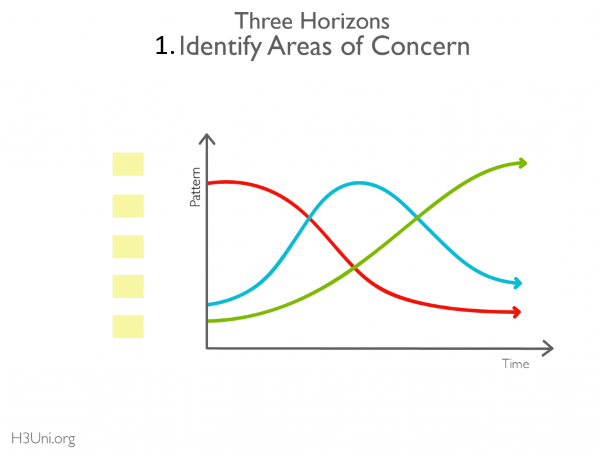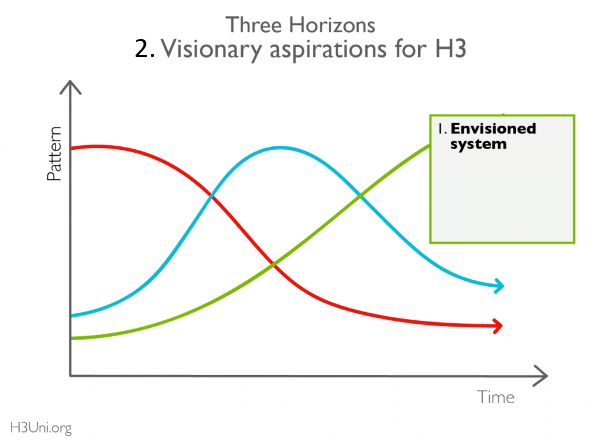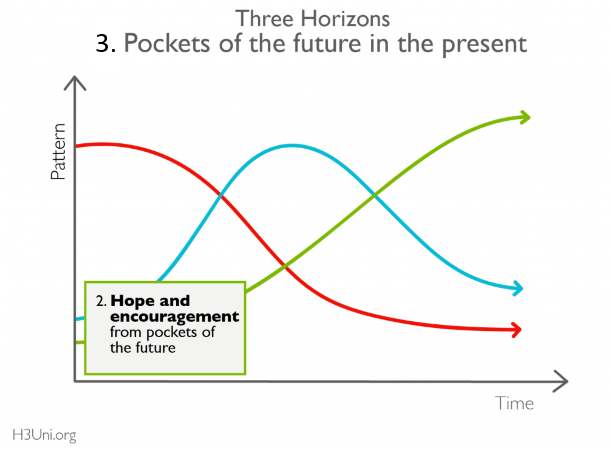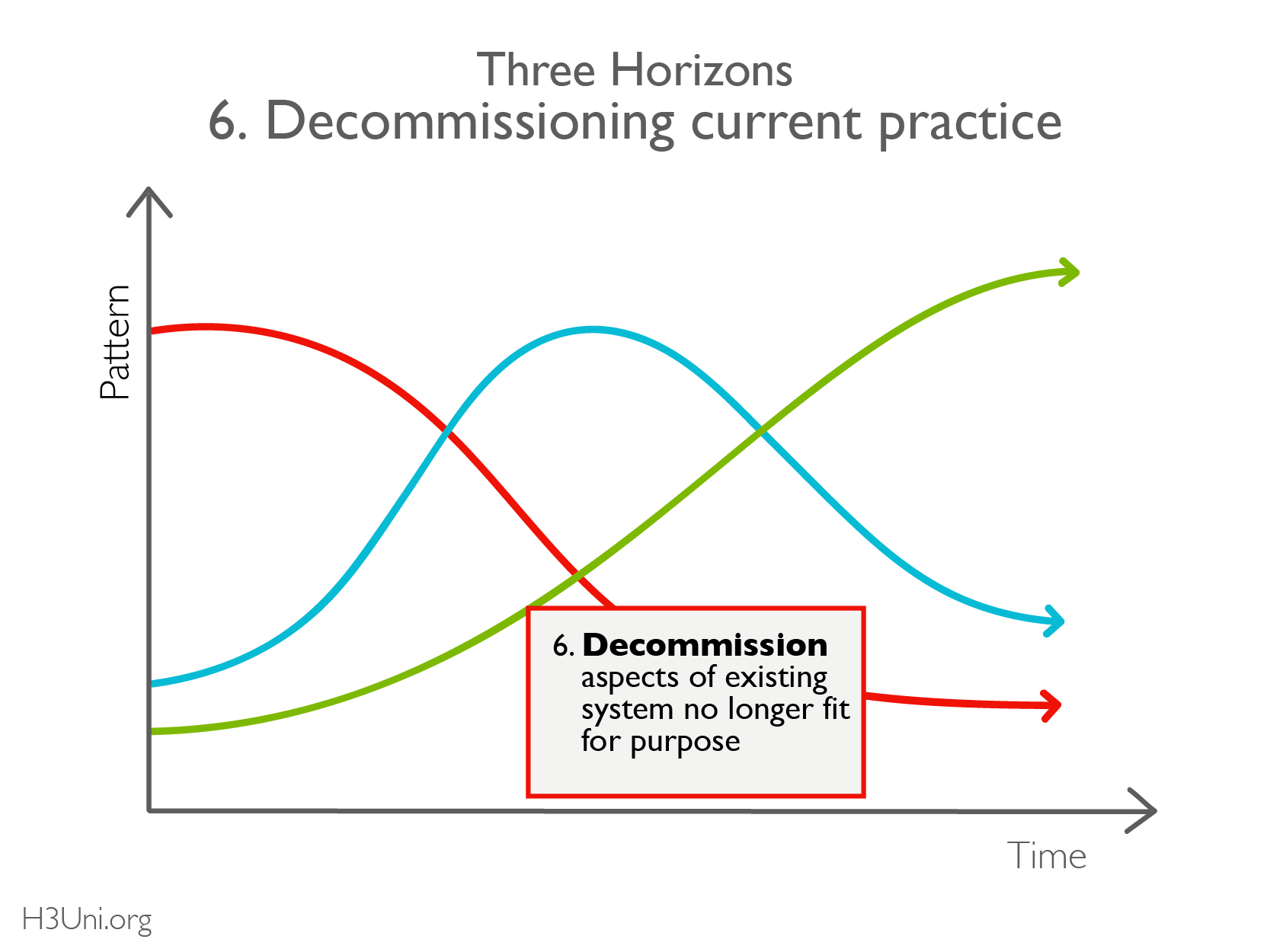Facilitation Guide
Three Horizons – Action Planning
Purpose
To enable a team to use a Three Horizon map to formulate an innovation pathway towards a third horizon vision.
When to use?
This is Stage 2 of the Three Horizon basic method, following on from Three Horizon Mapping. It is assumed that the team that developed the map wants to take action towards a desired third horizon future.
If this is following on directly from a Three Horizon mapping session, there will not have been the opportunity for deep enquiry in the dynamics of transformation or extended creative sessions to explore options. The emphasis therefore is likely to be on developing actions that start a process of movement and learning towards the third horizon, in anticipation of further conversations to deepen insight as progress is made.
The dynamics of innovation vary widely between cases where they change must be brought about from within the existing system or from outside. Innovation from within is common in public sector situations, whereas entrepreneurs in the market can stand apart and challenge the incumbents. This Guide is written with a bias to the more challenging situation of transformation from within, but can obviously be adapted to other situations.
Set Up
- A new 3H chart (just the basic lines) at the front of the room on which you will build up the innovation pathway. The layout also needs to keep the Phase 1 3H map visible throughout, available to work on for Step A and as source of the material for the remaining steps.
- Hexagons
- It is helpful to have larger rectangular stickies than those used for the capture stage for use in summarising.
- Flip chart on stand
Steps
Step 1: Identify areas of concern
- Ask the team to look at the first horizon stickies and identify a headline summary of an issue of concern, or indication of the system losing fit to the future. Write this on a (larger) sticky and put on the vertical axis of the 3H map. Ask for which stickies go with this issue and line them up next to it.
- Repeat until you have captured the main points – 5-7 should be enough to capture a shared understanding. Total agreement is not necessary, all views should be represented. The process should naturally run out of energy with a feeling that the current system has been understood.
- Alternative capture approach is to use a separate flip chart and then put up on left of the 3H map.
Step 2: Visionary aspirations for H3
- Complete Box 1
- This step is central to the whole process and requires the facilitator to make a skillful choice of clustering approach that will create an appropriate H3 description that is informed by the group’s ideals and well-connected to landscape of change without being purely idealistic – see more in the Hints and Tips.
- Transfer all the stickies from H3 on the map and place them on the flip chart.
- If you used Three Horizons Multi Actor Mapping then at this point you combine all the H3 stickies from all the perspectives onto the one flip chart.
- Choose a Clustering approach to create a small number of descriptively labelled clusters that describe the imagined H3 system.
- Transfer the cluster descriptions to Box 1.
Step 3: Pockets of future in the present
- Complete Box 2
- Having discussed a desirable future, it should be possible to identify aspects of that future happening already or features of current practice that can be built-upon.
- Summarise, as a set of bullet points in Box 2, the examples of H3 pockets of the future in the present that have already been recorded on the map.
- Add to them any additional contributions that come up.
- Prompt the group to consider those aspects of current practice, either in their own setting or anywhere else in the world, that give them hope and encouragement that the future they desire is indeed achievable because there are others moving in the same direction.
Step 4: Sustaining and transformative innovations
- Complete Boxes 3 and 4
- Revisit the H1 concerns from Step A and set up the task: “Considering what you have said about your desirable third horizon future (Box 1) and some of the things already happening that can encourage you to undertake the journey (Box 2). You are now ready to tackle the challenge of designing an innovation strategy that will both improve the existing system and help you make the transition to something even better. In completing these next boxes, you need firstly to identify the sustaining innovations that will help ‘keep the lights on’ i.e. keep the system running and address immediate concerns; and secondly the transformative innovations that will support the journey towards your longer-term aspirations. You need both.”
- Review the sticky notes in the middle ‘transition’ zone on the Three Horizons chart. Invite the team to select those that you think have a part to play in their future and that will make a difference. Place them on the ‘Planning for Transformation’ chart in the appropriate place: Box 3 for sustaining innovations, Box 4 for transformative innovations.
- Once the existing stickies have been used, invite more contributions. Trigger: “What are the innovations that are in play in your setting, in current policy, in your wider experience? Note that the transformative innovations will likely come from those stories of practice that particularly energise, excite or inspire you.
- Explore H2 plus and minus aspects. Some sustaining innovations can be tweaked to give them a greater focus on the emerging Third-Horizon vision. See whether any of the sustaining innovations could be modified to become transformative.
Step 5: H1 in the future
- Complete Box 5
- Capture any aspects of H1 that will play a continuing role in H3. This is for essential, foundational aspects of the existing system that will persist and be reconfigured in H3. Do not spend too long on this stage, it is a preparation for the final step (below), but it can help the group to see that the First Horizon can continue in new ways through transformation of its role.
Tips
- The dynamics of innovation, and therefore how this process will be experienced by the participants, varies widely between cases where they change must be brought about from within the existing system or from outside. Innovation from within is common in public sector situations, whereas entrepreneurs in the market can stand apart and challenge the incumbents.
- Our visionary aspirations are usually based on an implicit set of values that might not be held in common by all those involved in the conversation. If elements of the group’s aspirations seem incompatible, you may need a deeper discussion about values in order to clarify a shared vision of the future.
- Sifting the actions and innovations between sustaining and transformative is likely to be a novel process for most people but it is one of the advantages that the Three Horizons approach offers: the twin-track innovation process of ‘redesigning the plane whilst flying it’.
- Identifying transformative (H2+) innovations that shift the system towards a desired future is not easy. Inspiring examples of aspects of your desired future already happening in the present will provide some encouragement. This process will help to identify what such innovation might look like, but does not own provide a process for generating innovative ideas.
- The group are likely to find that a programme of ‘sustaining innovation’ is easier to deliver. For that reason, such a programme can easily squeeze out longer-term aspirations. One way to gain better appreciation of the journey towards these longer term aspirations is with the following set of reflections:
- First, step back and consider the transformative innovations listed in Box 4. View these as a set of ideas for how to make the transition from the First Horizon and its concerns to the Third Horizon and its aspirations.
- Identify the prominent routes – the ‘transition pathways’ – that emerge from your discussions. What will enable the transition? For example, it could be ‘professional development’ or ‘freedom to experiment with financial incentives’. Make a note of these.
- Finally, consider what actions you can initiate (these can be small-scale) to start exploring one of these transition pathways. These actions are the seeds of transformative innovation. You can draw on the content of Box 2 – Third Horizon activity that is already taking place in the present – for inspiration. You are looking for acorns at this stage, not oak trees. This should make initiating radical innovation feel less daunting.
![]()
Creative Commons Attribution-ShareAlike 4.0 International (CC BY-SA 4.0) license framework.
How to Use this License
CC BY-BY-SA
This license allows reusers to distribute, remix, adapt, and build upon the material in any medium or format, so long as attribution is given to the creator. The license allows for commercial use. If you remix, adapt, or build upon the material, you must license the modified material under identical terms.
Read about Open Access to H3Uni Methods and Materials





